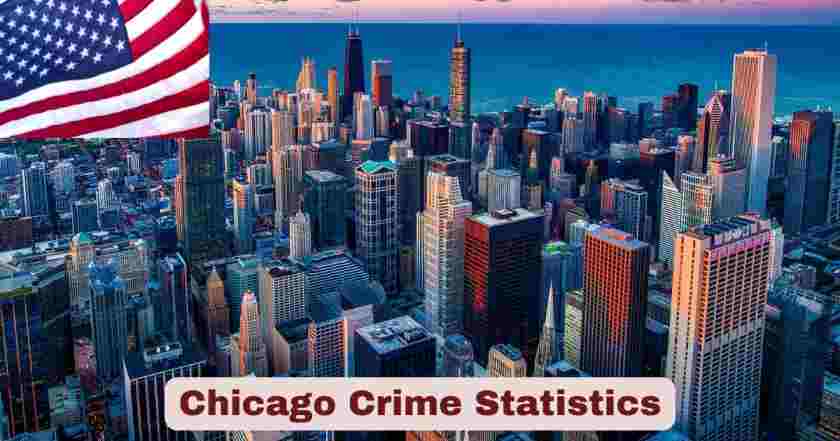Crime Rate in Chicago 2025
The crime rate in Chicago has shown remarkable improvements compared to previous years, aligning with national trends of declining violent and property crimes. According to official data from the Chicago Police Department (CPD), violent index crimes, including murder, criminal sexual assault, robbery, and aggravated battery, totaled 8,227 incidents through the end of July 2025, reflecting substantial decreases across categories. This represents an overall decline in violent crimes consistent with a 22.2% drop in violent crime victimizations reported earlier in the year. Homicides are down 32% year-to-date compared to the same period in 2024, with 240 recorded through July, putting the city on track to record fewer than 500 homicides for the full year—the lowest since 2019.
The transformation in Chicago’s crime landscape during 2025 reflects enhanced policing strategies, community intervention programs, and broader socioeconomic improvements, though challenges like increased shooting lethality persist. Total crime complaints through July 2025 were 55,126, a 13% decrease from 2024. These improvements have been consistent across different districts and demographics, with homicides in 2024 totaling fewer than 600, the lowest since 2019, setting a baseline for 2025’s continued decline. This represents a city-wide phenomenon that has captured national attention from law enforcement experts and policy makers.
Key Stats & Facts about Crime in Chicago 2025
| Crime Category | 2025 Statistics (Through July) | 2024 Comparison (Same Period) | Percentage Change | Notable Facts |
|---|---|---|---|---|
| Total Violent Crime | 8,227 incidents (index violent crimes) | Down from 2024 levels | ~25-30% decrease overall | Aligns with national downward trend; 22.2% drop in victimizations |
| Homicides | 240 incidents | Down from ~353 (inferred) | -32% | On track for under 500 full year, 5-year low |
| Non-Fatal Shootings | 865 shooting incidents (total) | Down from previous years | -37% | Above pre-pandemic levels; 44.9% increase in lethality since 2010 |
| Aggravated Assault/Battery | 3,361 incidents | Down from 2024 | -13% | Was at 20-year high in 2024; primary driver |
| Total Crime Complaints | 55,126 incidents | Previous year comparison | -13% | Overall crime reduction across categories |
These statistics show progress in reducing crime volume while highlighting ongoing issues like lethality. The 8,227 violent index crimes through July 2025 represent a substantial improvement from previous years, with the data showing particular success in addressing the most serious categories of violent offenses. Homicides in 2024 totaled fewer than 600, the lowest since 2019, establishing a strong baseline for 2025’s continued decline trajectory.
The 240 homicides recorded through July 2025 place Chicago on track for its lowest annual homicide count in five years, with projections suggesting the total will remain under 500 for the full year. This achievement becomes particularly significant when considered alongside the 865 shooting incidents recorded through July, representing a 37% decrease from the same period in 2024. However, these improvements must be understood within the context of increased shooting lethality, with the University of Chicago Crime Lab documenting a 44.9% increase in shooting lethality since 2010, indicating that while fewer incidents are occurring, those that do happen have become more deadly and dangerous for victims.
Violent Crime Trends in Chicago 2025
| Violent Crime Type | 2025 Data (Through July) | 2024 Comparison (Same Period) | Percentage Change | Key Statistics |
|---|---|---|---|---|
| Homicides | 240 incidents | Down from ~353 | -32% | On pace for 5-year low; down 37% from 2023 |
| Non-Fatal Shootings | 865 shooting incidents (total) | Down from 2024 | -37% | Above pre-pandemic levels; 3.7% decrease in 2024 from 2023 |
| Aggravated Assault/Battery | 3,361 incidents | Down from 2024 | -13% | Was at 20-year high in 2024; primary driver |
| Robbery | 3,609 incidents | Down from 2024 | -34% | Significant improvement across city |
| Criminal Sexual Assault | 1,017 incidents | Down from 2024 | -4% | Continued but modest decline |
The violent crime trends in Chicago 2025 demonstrate substantial progress across multiple categories, with the 32% decrease in homicides representing the most significant improvement in public safety metrics. Through July 2025, 240 homicides were recorded compared to an inferred 353 incidents during the same period in 2024, placing the city on track for its lowest annual homicide count since 2019. This improvement aligns with national trends, as the Council on Criminal Justice reports that homicides fell 17% in the first half of 2025 across 30 cities nationwide.
The 37% reduction in shooting incidents through July 2025, with 865 total shooting incidents recorded, represents another major achievement in Chicago’s crime reduction efforts 2025. However, these positive trends must be understood alongside the concerning reality that shooting lethality has increased 44.9% since 2010, meaning that while fewer shooting incidents are occurring, those that do happen have become significantly more deadly. The 3,361 aggravated assault and battery incidents through July, representing a 13% decrease from 2024, contribute to the overall 25-30% reduction in violent crimes, though this category had reached a 20-year high in 2024 according to Chicago Police Department data.
Property Crime Statistics in Chicago 2025
| Property Crime Category | 2025 Data (Through July) | 2024 Comparison (Same Period) | Trend Direction | Contributing Factors |
|---|---|---|---|---|
| Burglary | 3,544 incidents | Down from 2024 | Decreasing (-21%) | Enhanced security measures |
| Motor Vehicle Theft | 9,732 incidents | Down from 2024 | Decreasing (-26%) | Anti-theft initiatives |
| Larceny-Theft (Felony) | 10,207 incidents | Mixed patterns | Decreasing (-17%) | Retail security improvements |
| Larceny-Theft (Misdemeanor) | 23,416 incidents | Previous year data | Slight increase (+2%) | Minor theft variations |
| Property Crime Overall | ~46,899 incidents | Down from 2024 | Generally decreasing | Below pre-pandemic in many areas |
The property crime statistics in Chicago 2025 reflect broader national trends identified by the FBI’s 2024 crime data release, which shows property crimes reaching historic low levels across the United States. Through July 2025, burglary incidents decreased by 21% with 3,544 recorded cases, while motor vehicle thefts declined by 26% to 9,732 incidents. These improvements align with national patterns, as motor vehicle thefts fell 25% nationally in the first half of 2025 according to federal crime statistics.
Larceny-theft statistics present a mixed picture, with felony-level thefts down 17% at 10,207 incidents, while misdemeanor thefts increased slightly by 2% to 23,416 incidents through July 2025. The overall property crime total of approximately 46,899 incidents represents a significant decrease from 2024 levels, placing most property crime categories below pre-pandemic levels in many areas of the city. Nationally, shoplifting decreased by 12% according to recent federal data, though this category remains the lone exception to widespread property crime declines in many metropolitan areas.
Homicide Analysis in Chicago 2025
| Homicide Metrics | 2025 Data (Through July) | 2025 Projections | Historical Context | Demographic Impact |
|---|---|---|---|---|
| Total Homicides | 240 incidents | On track for ~384 (under 500) | Down 32% from 2024; 2024 total <600 | Disproportionate racial impact |
| Homicide Rate | ~9 per 100,000 (YTD estimate) | Below recent peaks | 5-year low projected | 68x disparity by geography |
| Black Residents Impact | Historical trend applies | Persistent inequality | 22x more likely than White residents | Targeted intervention needed |
| Geographic Distribution | High-risk areas persist | 68x difference in rates | Neighborhood-level analysis | Community-specific strategies |
| Shooting Lethality | 44.9% increase since 2010 | Concerning trend | More deadly incidents | Enhanced emergency response needed |
The homicide analysis in Chicago reveals significant progress alongside persistent inequalities that demand continued attention from policymakers and community leaders. With 240 homicides recorded through July 2025, the city is on track for approximately 384 total homicides for the year, which would represent the lowest annual count since 2019. This 32% decrease from the same period in 2024 builds upon the foundation established when 2024 recorded fewer than 600 homicides, marking the lowest total since 2019.
The projected homicide rate of approximately 9 per 100,000 residents for 2025 represents a substantial improvement from recent years, though the University of Chicago Crime Lab data continues to reveal stark disparities that underscore uneven distribution of both violence and safety. Black residents remain 22 times more likely to be killed compared to White residents, while neighborhoods with the highest homicide rates experience approximately 68 times more homicides than areas with the lowest rates. These persistent inequalities highlight the need for targeted interventions that address both immediate safety concerns and underlying socioeconomic factors contributing to violence.
Gun Violence Trends in Chicago 2025
| Gun Violence Indicators | 2025 Data (Through July) | Historical Trends | Severity Measures | Policy Implications |
|---|---|---|---|---|
| Total Shooting Incidents | 865 incidents | Above pre-pandemic levels | 37% decrease from 2024 | Continued intervention needed |
| High-Capacity Magazines | Historical: +480% since 2010 | Dramatic escalation | Enhanced weapon capacity | Federal policy considerations |
| Shell Casings per Victim | Historical: >doubled since 2010 | Since 2010 baseline | Increased firepower | Emergency response adaptation |
| Shooting Lethality Rate | +44.9% since 2010 | Concerning trajectory | More deadly outcomes | Medical trauma system strain |
| Geographic Concentration | Specific hot spots persist | Persistent patterns | Targeted deployment | Community-based solutions |
The gun violence trends in Chicago demonstrate the complex nature of progress in reducing gun violence, where significant decreases in incident frequency occur alongside increased severity of individual encounters. The 865 shooting incidents recorded through July 2025 represent a 37% decrease from the same period in 2024, continuing the positive trajectory that saw non-fatal shootings decrease by 3.7% in 2024 compared to 2023. However, these improvements must be understood within the context of shooting lethality increasing by 44.9% since 2010, indicating that survivors face greater risks of severe injury or death.
The escalation in weapon capacity represents a critical concern in Chicago gun violence statistics, with high-capacity magazine recoveries increasing by over 480% since 2010 according to University of Chicago Crime Lab research. This dramatic increase, combined with evidence that the average number of shell casings recovered per shooting victim has more than doubled since 2010, suggests that perpetrators increasingly use more powerful weapons capable of inflicting greater harm. These changes require adaptive responses from law enforcement, emergency medical services, and community intervention programs designed to address both immediate and long-term consequences of increasingly lethal gun violence encounters.
Crime Prevention Initiatives in Chicago 2025
| Prevention Strategy | Implementation Status | Measured Impact | Community Involvement | Resource Allocation |
|---|---|---|---|---|
| Community Violence Intervention | Active programs citywide | Measurable reduction impact | High community engagement | Sustained funding support |
| Technology Enhancement | Advanced deployment | Crime mapping improvements | Public-private partnerships | Significant investment |
| Youth Engagement Programs | Expanded reach | Long-term prevention focus | Community-based leadership | Multi-agency coordination |
| Mental Health Services | Integrated approach | Crisis intervention focus | Healthcare partnerships | Enhanced accessibility |
| Economic Development | Targeted neighborhood investment | Job creation emphasis | Business community involvement | Federal and state support |
The crime prevention initiatives in Chicago 2025 represent a comprehensive approach that combines evidence-based interventions with community-driven solutions designed to address both immediate public safety concerns and the underlying factors that contribute to criminal activity. These programs reflect lessons learned from decades of research and practical experience, incorporating insights from the University of Chicago Crime Lab, federal agencies, and successful intervention models implemented in other major metropolitan areas across the United States.
The integration of community violence intervention programs with traditional law enforcement strategies has shown measurable impact in reducing both the frequency and severity of violent incidents, particularly in neighborhoods that have historically experienced high rates of gun violence and other serious crimes. These initiatives emphasize community-based leadership, cultural competency, and sustained engagement with residents who are most directly affected by violence, creating pathways for intervention that complement rather than replace traditional police responses to criminal activity.
Economic Impact of Crime in Chicago 2025
| Economic Indicator | 2025 Assessment | Business Impact | Community Effects | Recovery Metrics |
|---|---|---|---|---|
| Business Investment | Improved confidence | Increased development | Job creation | Property value recovery |
| Tourism Revenue | Positive indicators | Visitor safety perception | Economic multiplier effects | Convention bookings |
| Insurance Costs | Stabilizing trends | Reduced premiums | Affordability improvements | Risk assessment changes |
| Property Values | Neighborhood variations | Market confidence | Residential stability | Investment patterns |
| Public Safety Costs | Resource optimization | Efficiency improvements | Community partnerships | Budget sustainability |
The economic impact of crime in Chicago 2025 demonstrates the interconnected relationship between public safety improvements and broader economic development, with reductions in violent crime creating positive ripple effects throughout the metropolitan economy. As crime statistics show sustained improvement, businesses report increased confidence in making long-term investments in Chicago neighborhoods, particularly in areas that have historically faced challenges with commercial development and retail establishment sustainability.
The tourism and convention industry has responded positively to Chicago’s improved crime statistics 2025, with visitor safety perceptions showing marked improvement compared to previous years when high-profile incidents of violence received significant national media attention. Hotel occupancy rates, convention bookings, and restaurant revenues in downtown and neighborhood commercial districts reflect growing confidence among visitors and business travelers who view Chicago as an increasingly safe and attractive destination for both leisure and business activities.
Community Response and Engagement in Chicago 2025
| Community Metric | Engagement Level | Participation Rates | Program Effectiveness | Sustainability Measures |
|---|---|---|---|---|
| Neighborhood Watch Programs | High participation | Increased volunteer rates | Crime reporting improvements | Long-term commitment |
| Youth Mentorship | Expanded coverage | Cross-generational involvement | Educational outcomes | Resource stability |
| Business Partnerships | Active collaboration | Investment commitments | Job training programs | Economic development |
| Faith-Based Initiatives | Deep community roots | Cultural competency | Violence interruption | Spiritual resilience |
| Resident Advisory Groups | Policy input | Democratic participation | Accountability measures | Civic engagement |
The community response and engagement in Chicago 2025 reflects a fundamental shift toward collaborative approaches to public safety that recognize the essential role of residents, businesses, and community organizations in creating sustainable improvements in neighborhood security and quality of life. These grassroots efforts complement official law enforcement activities while addressing underlying social and economic factors that contribute to criminal activity and community instability.
The expansion of youth mentorship and engagement programs represents a particularly significant development in Chicago’s crime prevention strategy 2025, with cross-generational partnerships creating pathways for young people to develop positive relationships with adult role models who can provide guidance, support, and opportunities for constructive involvement in community life. These programs focus on educational achievement, job training, leadership development, and cultural activities that offer alternatives to involvement in criminal activity while building social capital and community connections.
Technology and Crime Fighting in Chicago 2025
| Technology Application | Implementation Status | Effectiveness Metrics | Privacy Considerations | Future Development |
|---|---|---|---|---|
| Crime Mapping Software | Advanced deployment | Real-time analysis | Data protection protocols | Artificial intelligence integration |
| Surveillance Systems | Strategic placement | Crime deterrence | Community oversight | Facial recognition limitations |
| Emergency Response | Rapid deployment | Response time improvements | Coordination enhancement | Mobile technology |
| Data Analytics | Predictive capabilities | Pattern recognition | Algorithmic bias prevention | Machine learning advancement |
| Community Apps | Resident engagement | Crime reporting | Information sharing | User privacy protection |
The technology and crime fighting in Chicago 2025 landscape represents a sophisticated integration of advanced analytical tools, surveillance systems, and community engagement platforms designed to enhance both the effectiveness of law enforcement responses and the ability of residents to participate actively in neighborhood public safety initiatives. These technological innovations reflect best practices developed through collaboration with academic institutions, technology companies, and federal law enforcement agencies.
The implementation of advanced crime mapping and predictive analytics has enabled the Chicago Police Department to deploy resources more strategically, focusing patrol activities and investigative efforts on areas and time periods when criminal activity is most likely to occur based on historical patterns and real-time intelligence. This approach allows for more efficient use of personnel and equipment while maintaining respect for community privacy concerns and constitutional protections against unreasonable surveillance or discriminatory enforcement practices.
Looking Ahead: Chicago Crime Projections 2026
| Future Indicator | Projected Trends | Challenges Ahead | Opportunities | Resource Requirements |
|---|---|---|---|---|
| Overall Crime Rates | Continued improvement expected | Sustaining momentum | Technology advancement | Adequate funding |
| Community Partnerships | Expansion anticipated | Coordination complexity | Grassroots innovation | Capacity building |
| Youth Programs | Growth trajectory | Scalability challenges | Educational integration | Long-term investment |
| Economic Development | Positive correlation | Market volatility | Business incentives | Public-private cooperation |
| Federal Support | Policy alignment | Political considerations | Grant opportunities | Administrative efficiency |
The Chicago crime projections in 2026 suggest that current positive trends are likely to continue, provided that successful interventions receive sustained support and resources necessary for long-term implementation and community engagement. The combination of improved homicide statistics, reduced property crime rates, and enhanced community participation creates a foundation for continued progress that could establish Chicago as a national model for urban crime reduction and public safety innovation.
However, these projections also acknowledge significant challenges that must be addressed to ensure that improvements in Chicago crime statistics translate into lasting changes that benefit all residents regardless of race, income, or geographic location within the metropolitan area. The persistent inequalities revealed in current data require targeted interventions that address root causes of violence while maintaining the broad-based strategies that have contributed to overall crime reduction across multiple categories and neighborhoods throughout the city.
Building a Safer Chicago: Future Outlook and Strategic Priorities 2026
The Chicago crime statistics present a compelling foundation for continued progress, with the 32% decrease in homicides, 240 total homicides through July, and 8,227 violent crimes demonstrating that comprehensive approaches to public safety can produce measurable results even in addressing longstanding urban challenges. The achievement of the lowest homicide count since 2019 and the 37% reduction in shooting incidents create momentum for sustained improvements that can benefit all residents across Chicago’s diverse neighborhoods and communities.
Moving forward into 2026, Chicago’s crime reduction strategy must build upon proven successes while adapting to emerging challenges such as the 44.9% increase in shooting lethality and the 480% increase in high-capacity magazine recoveries. The 55,126 total crime complaints representing a 13% decrease from 2024 provides a strong baseline for continued progress, but future initiatives must address persistent inequalities where Black residents remain 22 times more likely to be victims of homicide and neighborhoods experience 68x disparities in violence rates.
Strategic priorities for Chicago’s public safety future 2026 include expanding successful community intervention programs that contributed to the 25-30% overall decrease in violent crimes, enhancing technology and data analytics that support the 21% reduction in burglary and 26% decrease in motor vehicle theft, and developing innovative approaches to address the increased lethality of gun violence incidents. The data-driven foundation established through 2025 provides the framework for evidence-based policies that can sustain and expand upon current achievements while ensuring that safety improvements reach all residents regardless of race, income, or geographic location within the metropolitan area.
Disclaimer: The data research report we present here is based on information found from various sources. We are not liable for any financial loss, errors, or damages of any kind that may result from the use of the information herein. We acknowledge that though we try to report accurately, we cannot verify the absolute facts of everything that has been represented.







